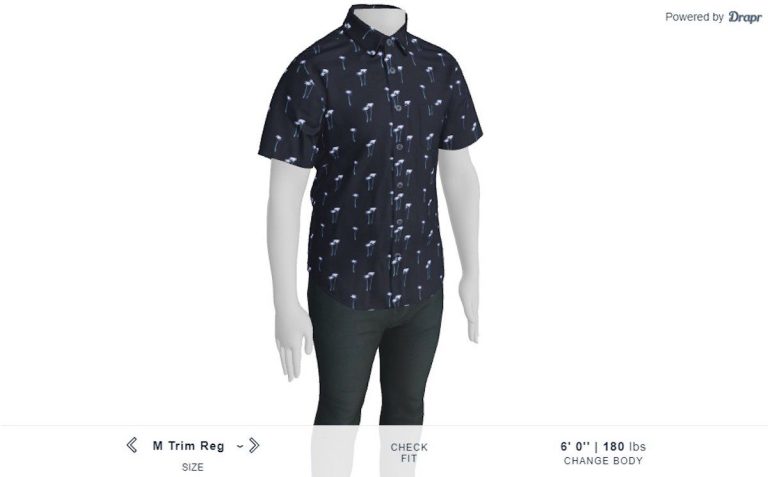
Gap Inc. has acquired eCommerce startup Drapr as part of the company’s increasing focus on digital sales, an initiative that helped boost the San Francisco-based apparel retailer to its best second-quarter sales in over a decade.
Drapr allows customers to quickly create 3-D avatars and virtually try on clothing, allowing them to find the best clothing size and fit for their style and body type, helping to reduce unnecessary returns.
Sally Gilligan, chief growth transformation officer at Gap Inc., said that fit is the No. 1 point of friction for customers, but “Drapr has shown it can help shoppers efficiently find the size and fit they need.” The acquisition, she said, will improve the fit experience for customers and help accelerate the company’s ongoing digital transformation.
The move also complements Gap Inc.’s launch of an integrated shopping experience at Old Navy, wherein all of its women’s styles in sizes 0 to 30 and XS to 4X will be displayed together online and in-store with no price difference. Mannequins have also been resized into sizes 4, 12 and 18, as have the selection of models displaying Old Navy apparel.
See more: Old Navy To Revamp Plus-Size Line With Integrated Shopping Experience
Nancy Green, president and CEO of Old Navy, said the addition of Drapr’s technology will help the brand continue to build on its expertise “and deliver a more personalized and inclusive fit experience for all of our customers.”
“Most people either don’t know their exact measurements or are looking for a specific type of fit that numbers alone can’t tell them,” Drapr Co-founder and CEO David Pastewka said in a statement. “Drapr has proven effective, and we are excited about the impact we can have on customers at scale as part of the Gap Inc. family.”
Realigning the Store Portfolio
Gap Inc. said it had $4.2 billion in net sales between April and July, up 29 percent versus 2020 and up 5 percent compared to two years ago. Comparable sales increased by 3 percent year over year and 12 percent versus 2019. Gap Inc’s online business grew by 65 percent in the second quarter compared to 2019, and contributed 33 percent of total sales in the quarter.
Broken out by brand, Old Navy saw a 21 percent increase in net sales and Athleta saw a 35 percent increase compared to 2019; Gap’s net sales declined by 10 percent and Banana Republic’s net sales declined by 15 percent, in part because of permanent store closures at both brands.
Last year, Gap Inc. said it would be closing 350 Gap and Banana Republic stores across North America, 75 percent of which will be completed by the end of this year. Year to date, 24 stores have been closed, with 51 more expected in the coming months. Last year, the retailer closed 189 stores.
Chief Financial Officer Katrina O’Connell said the company is also in discussions to move to a partnership model in France and Italy, and it plans to close all store locations in the U.K. and Ireland by the end of the year, though it will retain an online presence in those markets. In 2019, the CFO noted, the European market generated $539 million in net sales, about half of which came from the U.K. and Ireland at a slight operating loss.
Old Navy and Athleta, on the other hand, have opened 25 and 13 stores, respectively, so far this year; Old Navy will likely end the year with 30 to 40 new stores by year-end, and Athleta will likely end with 20 to 30 new stores.
Proud Partnerships
O’Connell told investors and analysts on a conference call that the company is pleased with the customer response to Gap Home, a collaboration with Walmart, as well as its 10-year partnership with Kanye West’s Yeezy brand. The Gap-Yeezy deal caused the $200 sky-blue “Round Jacket” to sell out in less than an hour in June, and the CFO said that 75 percent of customers who ordered the jacket were new to the Gap brand.
Read more: Gap-Yeezy Deal Reaps Instant Traffic Surge For 50-Year-Old Retailer
“We’re pleased with the customer response; it validated this partnership,” O’Connell said. “We’re pleased with the product pipeline that we have coming.” She added, though, that given the “coolness” of the partnership, future product drops will likely be revealed on social media rather than an earnings call.
“It’s following a creative process versus a more traditional process, and so that will lead to incremental excitement as this all builds,” she noted.
Looking ahead, executives said the company will likely look for more partnerships akin to the Gap Home line launched with Walmart earlier this year, looking specifically at categories like wellness and the “homebody economy.”
“We see a sizable future opportunity to compete in new categories,” O’Connell said.